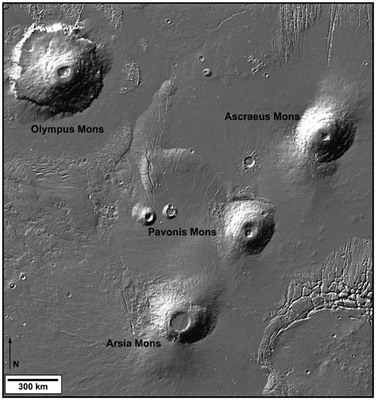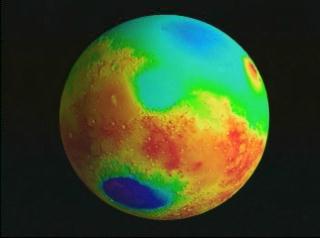
by Alexandra Ossola Thursday, January 5, 2012

This image from the Mars Orbiter Laser Altimeter, which flew onboard the Mars Global Surveyor, shows Olympus Mons and the three Tharsis Montes volcanoes: Arsia Mons, Pavonis Mons, and Ascraeus Mons. NASA

False color image of Mars showing its topography: blues and greens are lowlands, reds are highlands. NASA
Mars may be mythologically known as the Red Planet, but its topography can be as captivating as its celestial glow. Several striking features stand out with only a glance at a topographic map of Mars: the odd distribution of land on its surface and the equatorial string of giant volcanoes known as the Tharsis Rise. Since Mars has no plate tectonics, how these unique features formed has been a longstanding mystery. The answer, scientists now say, may be that instead of many plates sliding across the Red Planet’s surface as we have on Earth, the whole crust of crust moves as a single “shell.”
Earth’s surface consists of multiple tectonic plates, and their motion has produced an easily recognizable crustal dichotomy: Most of its land mass is in the northern hemisphere. Mars, on the other hand, does not have tectonic plates constantly shifting around its surface. Yet it does have its own crustal dichotomy, with most of its highlands concentrated in the southern hemisphere and lowlands predominating in the northern hemisphere.
The Tharsis Rise presents another mystery that plate tectonics can’t explain. Located more or less along the Martian equator, the Tharsis Rise contains four of the largest volcanoes in the solar system. Three of these, Arsia Mons, Pavonis Mons and Ascraeus Mons, fall into a neat line. Scientists have long hypothesized that these mountains formed because of a mantle plume, similar to the one that created Hawaii.
There are two standing theories for the asymmetry of the landmass in the northern and southern hemispheres, says Shijie Zhong of the University of Colorado in Boulder. Either the asymmetry was caused by processes in the interior of Mars, or there was a giant impact in the northern hemisphere that then spewed ejecta into the southern hemisphere. Proponents of the internal, or endogenic, theory have suggested that Mars’ crust rotates like a shell around the planet’s interior.
Using 3-D models, Zhong and his collaborators proved that the “differential rotation” of a single plate was easily possible — provided that two necessary conditions were in place. First, you need “degree-one convection,” which entails one source of upwelling in a single hemisphere (in this case Mars’ northern hemisphere), so the other hemisphere will be devoid of volcanic activity. Also necessary is lateral variation, or the physical movement of the plate, which is often facilitated when there is lots of melt present.
Although this is difficult to test directly, Zhong’s shell model of Mars is “probably right,” says Francis Nimmo, a geologist at the University of California in Santa Cruz. “The one plume has extracted lots of melt, and it has a big effect,” Nimmo says.
Mars’ “shell tectonics,” therefore, could not only produce a crustal dichotomy, but could also explain the volcanoes of the Tharsis Rise — essentially, they would be the result of this single large source of upwelling.
Although the Tharsis Rise formed very rapidly and early in Mars’ history (about 3.8 billion years ago), Zhong thinks that this single plume (or a “cluster plume”) is not yet extinct. “It’s still active, but not as active as 3.8 billion years ago,” Zhong says. This may mean that Mars is in for another volcanic episode in the future. “The direct consequence [of my research] is that we can plan migration of the volcanism,” Zhong says.
The shell tectonics theory requires one source of upwelling, but there are volcanoes on the opposite hemisphere from Tharsis, such as Elysium Mons. However, they formed much later in the planet’s history, Zhong says. “Elysium Mons is one magnitude smaller and has much younger features,” he says. “[This] theory is more applicable to early Mars when the mantle had more water. As planet dehydrated, more upwelling systems were created in other parts of the planet.”
Zhong’s research leads us closer to solving the mystery of Mars’ crustal dichotomy. “It’s a step in the process,” Nimmo says. And Zhong’s predictions can potentially be tested on the Red Planet by analyzing the nature of the faults around the equatorial bulge.
But the models also have larger implications. “One of the things that is most interesting is that [Zhong’s research] may have applications beyond Mars,” Nimmo says. If the theories can be applied to other planets, he adds, we may finally be able to discover more of the inner-workings of celestial bodies that are light-years away.
© 2008-2021. All rights reserved. Any copying, redistribution or retransmission of any of the contents of this service without the expressed written permission of the American Geosciences Institute is expressly prohibited. Click here for all copyright requests.